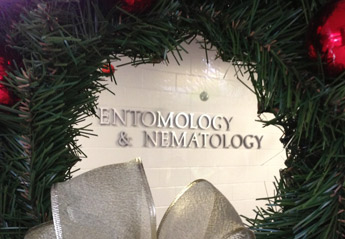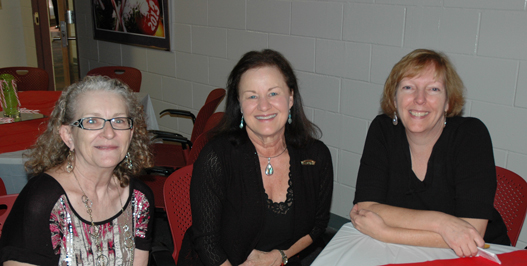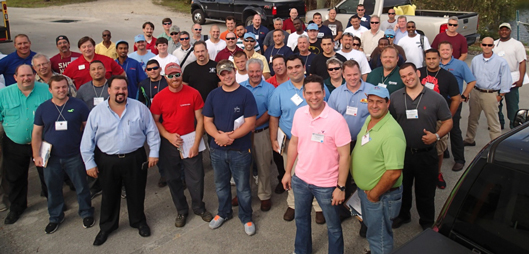- Faculty News
- Student News
- Lab News
- Publications
- Meetings and Presentations
- Outreach
- Grants
- Announcements
- About This Newsletter

ABOVE: From everyone in the UF/IFAS Entomology & Nematology family, we hope you and yours have a very safe and happy holiday break. See you in January!
Dr. Gregg Nuessly will be assuming the role of Interim Center Director at the Everglades Research and Education Center on December 17th following the appointment of our current Center Director Dr. Robert Gilbert to the position of chair for the Agronomy Department on main campus.
 Dr. Oscar Liburd was the guest of honor at a one-day conference on IPM of fruits and vegetables on Saturday, November 30th, at the University of Agriculture in Faisalabad, Pakistan. Dr. Liburd gave the feature address to 150 students and faculty. The title of his invited lecture was "Managing horticultural pests using IPM techniques with the goal of reducing pesticide residues on fruits and vegetables."
Dr. Oscar Liburd was the guest of honor at a one-day conference on IPM of fruits and vegetables on Saturday, November 30th, at the University of Agriculture in Faisalabad, Pakistan. Dr. Liburd gave the feature address to 150 students and faculty. The title of his invited lecture was "Managing horticultural pests using IPM techniques with the goal of reducing pesticide residues on fruits and vegetables."
Dr. Liburd gave a seminar on Monday, November 25th, to faculty and students in the Department of Entomology, University of Agriculture in Faisalabad, Pakistan. He was invited to speak about managing invasive pests in fruits and vegetables using IPM techniques.
 There is an article about Dr. Nabil Killiny's work in Central Florida Ag News magazine.
There is an article about Dr. Nabil Killiny's work in Central Florida Ag News magazine.
 Dr. Barry Alto will be the recipient of the Richard Jones Outstanding New Faculty Research Award for 2014. This award is from the IFAS Dean for Research Office.
Dr. Barry Alto will be the recipient of the Richard Jones Outstanding New Faculty Research Award for 2014. This award is from the IFAS Dean for Research Office.
This award is presented to untenured faculty who have begun a distinguished record of research since arriving at UF/IFAS. The purpose of the award is to recognize the development of the recipient's research program and its recent contributions to the scientific field. The award will be presented on May 14th, 2014 at the 7th Annual Florida Agricultural Experiment Station Awards Ceremony.
 Dr. Christine Miller wrote a special column titled "Engage Students in Science" for the Sunday, Nov. 3rd edition of the Gainesville Sun.
Dr. Christine Miller wrote a special column titled "Engage Students in Science" for the Sunday, Nov. 3rd edition of the Gainesville Sun.
 Dr. James P. Cuda was invited to serve as an Associate Editor for the Journal of Aquatic Plant Management.
Dr. James P. Cuda was invited to serve as an Associate Editor for the Journal of Aquatic Plant Management.


ABOVE:We had a great turn-out for our 2013 Holiday Lunch. It was a great chance to catch up with friends. Here, Debbie Hall, Debbie Boyd, and Dr. Heather McAuslane enjoy a quiet minute together. Photograph by Jane Medley.
Garima Kakkar and Maria Cristina Carrasquilla were awarded the department’s Nan Yao Su Scholarships for 2013 ($1,500 each). This award recognizes academically outstanding graduate students who represent well the science of entomology or nematology to their peers and the public.


ABOVE: The Florida Mosquito Control Foundation congratulates the winners of the 2013 T. W. Miller Scholarships:
1st Place: Eva Buckner, Ph.D. student (from the Lounibos and Alto labs) $2000
Runner up: Kylie Zirbel, Ph.D. student (from the Alto lab) $500
Runner up: Robert Aldridge, M.S. student (from the Kaufman and Linthicum labs) $500
 Lacey Jenson (Ph.D.) and Nick Larson (M.S.) successfully defended their graduate degrees in November. Both students worked in the Bloomquist Lab.
Lacey Jenson (Ph.D.) and Nick Larson (M.S.) successfully defended their graduate degrees in November. Both students worked in the Bloomquist Lab.
 Lorena Lopez presented a poster, "Acute toxicity of fenpyroximate to Amblyseius swirskii (Acari: Phytoseiidae)," at the ESA meeting in Austin, TX. Coauthors were Hugh A. Smith and Marjorie A. Hoy.
Lorena Lopez presented a poster, "Acute toxicity of fenpyroximate to Amblyseius swirskii (Acari: Phytoseiidae)," at the ESA meeting in Austin, TX. Coauthors were Hugh A. Smith and Marjorie A. Hoy.
Aaron Pomerantz presented a talk, "Expression and functional analysis of putative sex-determining genes in Metaseiulus occidentalis (Acari: Phytoseiidae)," at the ESA meeting in Austin, TX. Coauthors were Marjorie A. Hoy and Akito Kawahara.
Al Estep presented a poster at the ESA meeting in Austin, TX, "Putative circadian and phototransduction orthologs in the Wesern predatory mite (Metaseiulus occidentalis)." The coauthor was Marjorie A. Hoy.
Haleigh Ray presented a talk, "Assessment of Hemicheyletia wellsina (Acari: Cheyletidae) as a potential predator for biological control of arthropod pests on orchids," at the ESA meeting in Austin, TX. The coauthor was Marjorie A. Hoy.
Haleigh Ray was awarded a travel grant from the Acarological Society of America at the Acarology Society of America business meeting. Only one travel award was presented.
Need to name that bug? A host of experts are available to help Floridians identify any insect or related arthropod. If a mystery creature has six or more legs, the UF Insect ID Lab is the place to call.
In December 2012, Dr. Rebecca Baldwin gave Lyle a sample from a pest management professional in New York City. It was a sticky trap containing two cockroaches that were unfamiliar to all of us. One reference book gave Lyle the idea that it could be Periplaneta japonica, an Asian species not known to be in the United States.
There are not many entomologists around with expertise in identification of exotic roaches, but Lyle found a lab at Rutgers University that was doing DNA barcoding work on roaches. Researchers Dominic Evangelista and Jessica Ware confirmed that the roaches were indeed the Japanese cockroach, P. japonica, a species that occurs in Japan, China, and Korea. It is cold tolerant, and therefore may be well adapted to surviving indoors and outdoors in New York City. A more complete article will be published soon in the latest issue of the Journal of Economic Entomology.
Lyle Buss is the Insect ID Lab manager.
 Think it might be a nematode problem? The Nematode Assay Laboratory serves Florida and other states by providing nematode assays and expert advice regarding nematode management.
Think it might be a nematode problem? The Nematode Assay Laboratory serves Florida and other states by providing nematode assays and expert advice regarding nematode management.
The Nematode Assay Lab will be undergoing construction which will begin December 18th and may continue until the start of the Spring semester (January 6th). During this time we will not have access to our extraction equipment, and we will therefore be unable to process samples. Samples received during this time will be placed in cool storage and processed when the laboratory reopens.
For more information on the Nematode Assay Laboratory please contact the lab manager Dr. Tesfa Mengistu.
Alto BW, Lampman RL, Kesavaraju B, Muturi EJ. 2013. Pesticide-induced release from competition among competing Aedes aegypti and Aedes albopictus (Diptera: Culicidae). Journal of Medical Entomology 50: 1240-1249.
Avery PB, Pick DA, Aristizábal L, Kerrigan J, Powell CA, Rogers ME, Arthurs SP. 2013. Compatibility of Isaria fumosorosea (Hypocreales: Cordycipitaceae) blastospores with agricultural chemicals used for management of the Asian citrus psyllid, Diaphorina citri (Hemiptera: Liviidae). Insects 4: 694-711. doi:10.3390/insects4040694
Buckner EA, Lounibos LP, Alto BW. 2013. Infection, dissemination, and vertical transmission of Key West dengue-1 virus by Aedes aegypti and Aedes albopictus (Diptera: Culicidae) mosquitoes from Florida. Journal of Medical Entomology 50: 1291-1297.
Killiny N, Almeida RP. 2013. Factors affecting the initial adhesion and retention of the plant pathogen Xylella fastidiosa in the foregut of an insect vector. Applied Environmental Microbiology. 2013 Nov 1. [Epub ahead of print]
Kotarides JL, Liburd OE. 2013. Visual and olfactory stimuli affecting the response of Rhagoletis cingulata (Loew) and R. fausta (Osten Sacken) (Diptera: Tephritidae). Pakistan Entomologist 35: 55-60.
Langeland KA, Meisenberg MJ, Cuda JP. 2013. Natural Area Weeds: A Property Owner’s Guide to Melaleuca Control. http://edis.ifas.ufl.edu/ag241
Langeland KA, Meisenberg MJ, Cuda JP, Diaz R, Manrique V. 2013. Malezas de Áreas Naturales: Una Guía Para el Propietario Sobre el Control de Melalueca. http://edis.ifas.ufl.edu/ag264
Lee JC, Shearer PW, Barrantes LD, Beers EH, Burrack HJ, Dalton DT, Dreves AJ, Gut LJ, Hamby KA, Haviland DR, Isaacs R, Nielsen AL, Richardson T, Rodriguez-Saona CR, Stanley CA, Walsh DB, Walton VM, Yee WL, Zalom FG, Bruck DJ. 2013. Trap designs for monitoring Drosophila suzukii (Diptera: Drosophilidae). Environmental Entomology doi: 10.1603/EN13148
Miller CW. 2013. Sexual selection: male-male competition. In: J. Losos, Editor. The Princeton Guide to Evolution. Princeton University Press.
 New on Featured Creatures:
New on Featured Creatures:
Do you have a favorite creature? Learn how to make it into a Featured Creature!eastern bloodsucking conenose, Triatoma sanguisuga (LeConte). Authors: Morgan A. Conn and John L. Capinera.
Sri Lankan weevil, Myllocerus undecimpustulatus undatus Marshall. Author: Anita Neal.
lone star tick, Ambylomma americanum (Linnaeus). Authors: Christopher J. Holderman and Phillip E. Kaufman.
The Florida Academy of Sciences will hold its Annual Meeting at the Indian River State College, Fort Pierce, FL, March 7th and 8th, 2014. Students may be interested in presenting their research at this meeting and can submit here. Abstracts from oral presentations will be published in the Florida Scientist. Contact Dr. Steve Arthurs for further details.
 The University of Florida School of Structural Fumigation was held at the Ft. Lauderdale R.E.C. November 18th to the 22nd. The annual "Fume School" provides classroom, laboratory, and field training for pest control professionals who wish to supervise or conduct fumigations of buildings and goods against various pest infestations. This is the only school of its kind in the world, and the school’s 25th anniversary witnessed the 1,000th student to complete the program.
The University of Florida School of Structural Fumigation was held at the Ft. Lauderdale R.E.C. November 18th to the 22nd. The annual "Fume School" provides classroom, laboratory, and field training for pest control professionals who wish to supervise or conduct fumigations of buildings and goods against various pest infestations. This is the only school of its kind in the world, and the school’s 25th anniversary witnessed the 1,000th student to complete the program.

ABOVE: This year’s Fume School class included 57 students from Florida and nine other states and participants from Puerto Rico, Dominican Republic, and Grand Cayman. The school’s director, Renny Perez, was interviewed by Telemundo for an upcoming story about fumgation and the school. Dr. Rudi Scheffrahn and Dr. Bill Kern have coordinated the Fume School at FLREC for the past 10 years.
 Dr. James P. Cuda and Dr. William Overholt were co-authors on a symposium presentation at the 2013 ESA annual meeting held in Austin, Texas, November 10th to 13th. The presentation, which was titled "Partnerships in weed biological control: the quest for Old World natural enemies of cogongrass," was part of a Member Symposium: Making Connections Across Disciplines to Combat Alien Invaders.
Dr. James P. Cuda and Dr. William Overholt were co-authors on a symposium presentation at the 2013 ESA annual meeting held in Austin, Texas, November 10th to 13th. The presentation, which was titled "Partnerships in weed biological control: the quest for Old World natural enemies of cogongrass," was part of a Member Symposium: Making Connections Across Disciplines to Combat Alien Invaders.
Dr. James P. Cuda was invited by the Reclamation and Hydrology Technical Advisory Committee of the Florida Industrial and Phosphate Research Institute to give a presentation in Bartow, FL, 21 November, on his Brazilian peppertree biological control project funded by FIPR. Cuda’s presentation was titled, "Update: Screening of a New Candidate BioControl Agent of Brazilian Peppertree, Schinus terebinthifolia."
 Dr. Marjorie A. Hoy presented an invited symposium talk, "RNAi and Metaseiulus occidentalis," at the ESA meeting in Austin, Texas. Dr. Ke Wu was the coauthor.
Dr. Marjorie A. Hoy presented an invited symposium talk, "RNAi and Metaseiulus occidentalis," at the ESA meeting in Austin, Texas. Dr. Ke Wu was the coauthor.
 The ESA 61st Annual Meeting was held on November 10th to the 13th at the Austin Convention Center in Austin, Texas.
The ESA 61st Annual Meeting was held on November 10th to the 13th at the Austin Convention Center in Austin, Texas.
Qianju Jia, Akito Kawahara, Moneen Jones, and Philip A. Stansly presented, Systematics, host plants and life histories of Phyllocnistis species on citrus (Lepidoptera, Gracillariidae, Phyllocnistinae).
Philip A. Stansly, Barry C. Kostyk, and Jose Castillo presented, Pests of fruiting vegetables and their management in subtropical Florida.
Philip A. Stansly presented, Asian citrus psyllid control, past, present and future.
Jawwad A. Qureshi and Philip A. Stansly presented their research, Role of biological control in the management of Asian citrus psyllid vector of Huanglongbing.
Cesar Monzo and Philip A. Stansly presented, Economic injury level model for Asian citrus psyllid control in citrus groves with high incidence of HLB.
Pilar Vanaclocha and Philip A. Stansly presented the poster, The Citrus greening bibliographical database.
Moneen Jones and Philip A. Stansly presented, Effective management of Asian citrus psyllid in Florida citrus using low volume horticultural oil.
Scott D. Croxton and Philip A. Stansly presented a poster, Foiling the yellow dragon, and an oral presentation, Asian citrus psyllid (Diaphorina citri) seasonal movement and spatial distribution patterns.
Xulin Chen and Philip A. Stansly presented, The influence of diet on egg formation in Tamarixia radiata (Waterston) (Hymenoptera: Eulophidae), a parasitoid of Diaphorina citri (Kuwayama) (Hemiptera: Psyllidae).
From the Outreach Coordinator
The live critters are always a hit with children and adults alike. The critters are available for you to check out should you be leading an outreach event. We have doubles of our most popular critters, as well as various native insect species depending on the time of year. We have large wood and Plexiglas cages for viewing our native orb weaving spiders. There is one travel cage and one larger static cage. Please be sure to contact us and review the protocol on transporting and handling the critters if you are not already familiar with it. If you lead an outreach, be sure to fill out a documentation form so your event can be included in the newsletter and we can log all outreach events.
If you would like to schedule an event or have any outreach questions, go to the Outreach pages on our Bug Club Website and contact us. I look forward to working with all of you over the next four years.
- Stephanie Stocks, Outreach Coordinator
- Office number 352-273-3958
 Getting social!
Getting social!
We have several social media sites for the Entomology & Nematology Department. To make them easily searchable, all three (YouTube, Facebook and Twitter) have the same page name: UFEntomology. Please share these links with past students or colleagues who may have an interest in departmental activities.
We like to share news when it happens using our social media outlets: Twitter, Facebook and YouTube. Follow us on these sites for daily updates! When you send news, we will post it on one or more of these sites and again in the monthly newsletter. Please be sure you have permission from people in photographs you submit for publication.
UF-Bugnews-L listserv subscribers receive notices when issues are posted. Our home page has instructions for subscribing and unsubscribing.
Special thanks to Dr. Verena Lietze and Nancy Sanders who reviewed the newsletter for errors and to Jane Medley and Don Wasik who built the web page design.